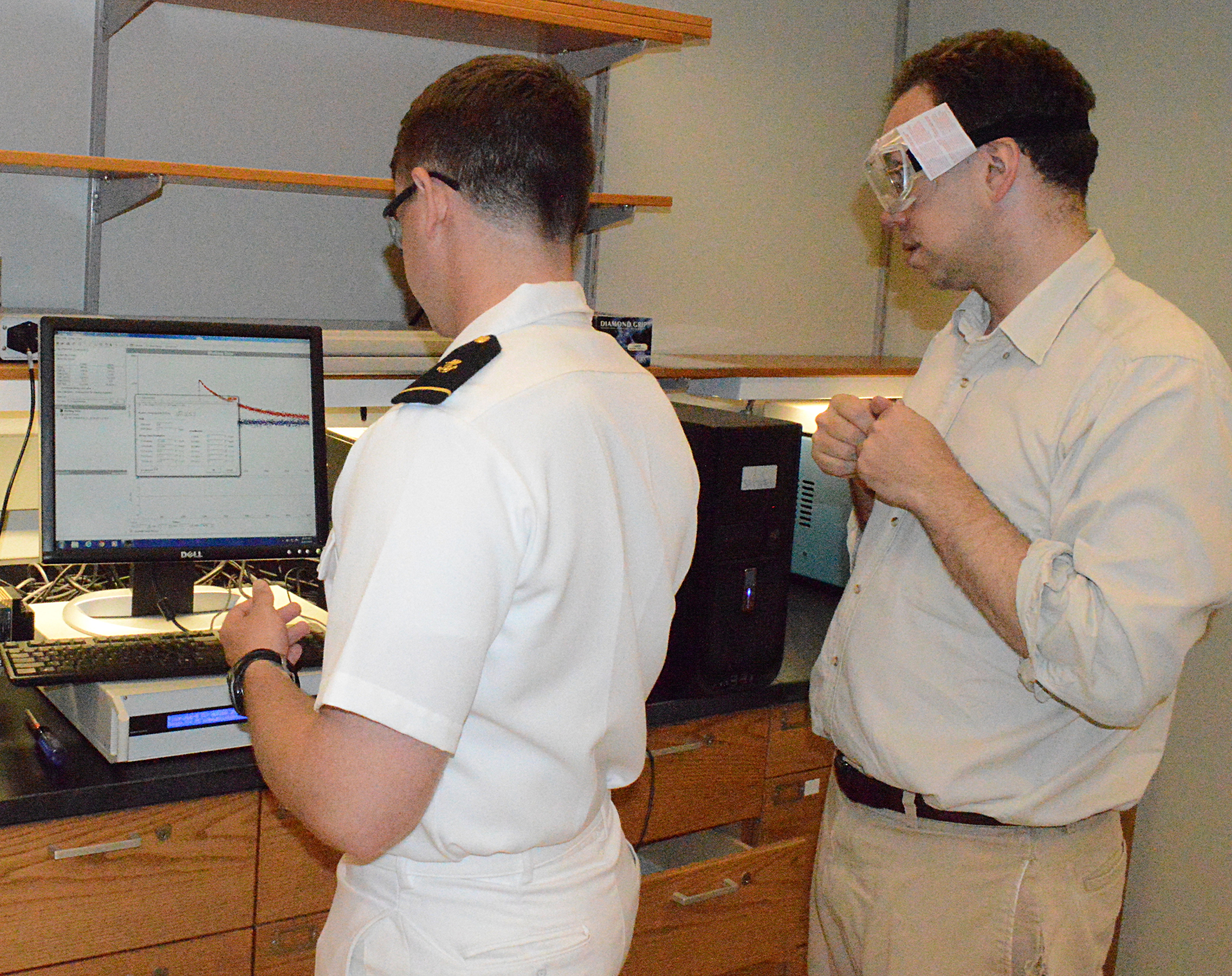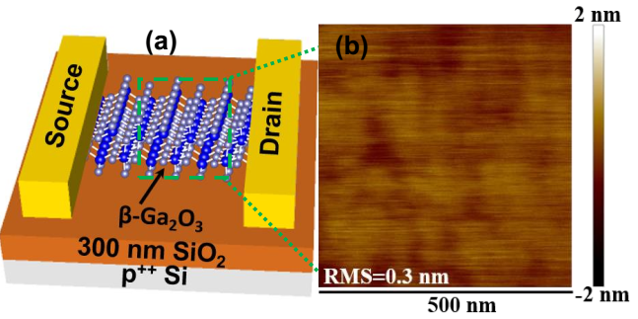
Power Electronics
Project Description
Power electronics are a key technology that underpins many critical applications, which include radio frequency communications (such as cell phones), hybrid and electric automobiles, electric ships, and more-electric aircraft. A key limitation associated with each power electronic material platform is its capacity to handle high powers at frequencies ranging from DC to gigahertz. These limitations translate into limits of operational regimes, efficiency, and endurance. While certain materials such as gallium nitride offer major advantages over previously established technologies such as silicon, and are now also available commercially, there is still great potential for substantial further improvements with new choices of materials. Here, we focus on monoclinic beta gallium oxide (β-Ga2O3) with an ultra-wide bandgap of 4.6-4.9 eV, which has been identified as a promising contender for the next generation naval power electronics applications. Its larger bandgap means that it can support higher voltages per unit thickness. The improvement at low frequencies can be quantified using Baliga’s figure of merit (BFM), which indicates that the relatively high BFM of 850 for bulk GaN can be increased to 3444 with beta-gallium oxide.
Zhou, Hong, Mengwei Si, Sami Alghamdi, Gang Qiu, Lingming Yang, and Peide D. Ye. "High-performance depletion/enhancement-mode β-Ga2O3 on insulator (GOOI) field-effect transistors with record drain currents of 600/450 mA/mm." IEEE Electron Device Lett 38, no. 1 (2017): 103-106.
Recent Innovations
Recently, our team made a breakthrough in increasing the β-Ga2O3 field and has successfully demonstrated high performance D-mode and E-mode FETs with record high ID, record low Ron, high on/off ratio, low subthreshold swing (SS), and negligible hysteresis. The current is 1-2 orders of magnitude higher than previously reported values from groups in the US, Europe and Asia. In this project, we will apply an atomic layer epitaxially-deposited dielectric on β-Ga2O3 with the highest interface quality and demonstrate the unprecedented device performance for naval power electronics applications. In Year 1, ALE dielectric technique on β-Ga2O3 will be first developed and realize interface trap density Dit <1011/cm2-eV by optimize surface pre-cleaning, MgCaO deposition, post dielectric annealing processes. The PI and co-PI will collaborate and characterize the interface quality by electrical (photo-assisted CV method and conductance methods) and optical (photo-excited carrier lifetimes and time-resolved photoluminescence) characterizations. The information obtained by interface characterization will feedback to subsequent process optimization and device designs. In Year 2, we will fine-tune the ALE process and insert the optimized gate dielectric process into a D-mode or E-mode b-Ga2O3 MOSFETs which we just developed using the conventional SiO2 as dielectric as shown in Fig.1. With optimized interface and significant improvement of surface mobility, we expect to achieve another factor of 3-5 improvement in terms of maximum drain current, making -Ga2O3 a real contender to GaN. In Year 3, we will focus on E-mode or Normally-off devices and realize high performed power switch devices with low on-resistance and high breakdown voltage from 600V, 900V up to 1400V. The PI Peide Ye and co-PI Peter Bermel have an excellent track record on their innovative research on dielectric and semiconductor device technologies.
Publications
Zhou, Hong, Mengwei Si, Sami Alghamdi, Gang Qiu, Lingming Yang, and Peide D. Ye. "High-performance depletion/enhancement-mode β-Ga2O3 on insulator (GOOI) field-effect transistors with record drain currents of 600/450 mA/mm." IEEE Electron Device Lett 38, no. 1 (2017): 103-106.
Zhou, Hong, Kerry Maize, Gang Qiu, Ali Shakouri, and Peide D. Ye. "β-Ga2O3 on insulator field-effect transistors with drain currents exceeding 1.5 A/mm and their self-heating effect." Applied Physics Letters 111, no. 9 (2017): 092102.
Zhou, Hong, Sami Alghmadi, Mengwei Si, Gang Qiu, and D. Ye Peide. "Al2O3/ β -Ga2O3 (-201) Interface Improvement Through Piranha Pretreatment and Postdeposition Annealing." IEEE Electron Device Letters 37, no. 11 (2016): 1411-1414.
Bhuiyan, Maruf A., Hong Zhou, Rong Jiang, En Xia Zhang, Daniel M. Fleetwood, D. Ye Peide, and Tso-Ping Ma. "Charge Trapping in Al2O3/β-Ga2O3 Based MOS Capacitors." IEEE Electron Device Letters (2018).
Zhou, Hong, Kerry Maize, Jinhyun Noh, Ali Shakouri, and Peide D. Ye. "Thermodynamic Studies of β-Ga2O3Nanomembrane Field-Effect Transistors on a Sapphire Substrate." ACS Omega 2, no. 11 (2017): 7723-7729.
Si, Mengwei, Lingming Yang, Hong Zhou, and Peide D. Ye. "β-Ga2O3 Nanomembrane Negative Capacitance Field-Effect Transistors with Steep Subthreshold Slope for Wide Band Gap Logic Applications." ACS Omega 2, no. 10 (2017): 7136-7140.
K Lou, Xiabing, Hong Zhou, Sang Bok Kim, Sami Alghamdi, Xian Gong, Jun Feng, Xinwei Wang, Peide D. Ye, and Roy G. Gordon. "Epitaxial Growth of Mg x Ca1–x O on GaN by Atomic Layer Deposition." Nano letters 16, no. 12 (2016): 7650-7654.
Zhou, Hong, Xiabing Lou, Nathan J. Conrad, Mengwei Si, Heng Wu, Sami Alghamdi, Shiping Guo, Roy G. Gordon, and D. Ye Peide. "High-performance InAlN/GaN MOSHEMTs enabled by atomic layer epitaxy MgCaO as gate dielectric." IEEE Electron Device Letters 37, no. 5 (2016): 556-559.
Zhou, Hong, Xiabing Lou, Sang Bok Kim, Kelson D. Chabak, Roy G. Gordon, and D. Ye Peide. "Enhancement-mode AlGaN/GaN Fin-MOSHEMTs on Si substrate with atomic layer epitaxy MgCaO." IEEE Electron Device Letters 38, no. 9 (2017): 1294-1297.
Moore, James E., Xufeng Wang, Elizabeth K. Grubbs, Jennifer Drayton, Steve Johnston, Dean Levi, Mark S. Lundstrom, and Peter Bermel. "Photoluminescence excitation spectroscopy characterization of cadmium telluride solar cells." In Photovoltaic Specialist Conference (PVSC), 2017 IEEE 44th, pp. 1-5. IEEE, 2017.
Boriskina, Svetlana V., Martin A. Green, Kylie Catchpole, Eli Yablonovitch, Matthew C. Beard, Yoshitaka Okada, Stephan Lany et al. "Roadmap on optical energy conversion." Journal of Optics 18, no. 7 (2016): 073004.
Researchers
Contact Information
Peide Ye
Richard J. and Mary Jo Schwartz Professor
School of Electrical and Computer Engineering
Email: yep
Peter Bermel
Associate Professor
School of Electrical and Computer Engineering
Email: pbermel

